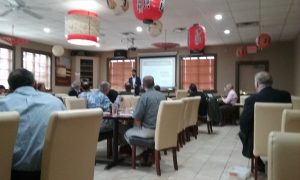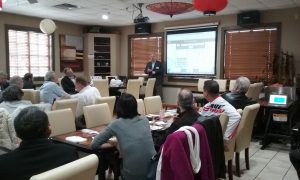We started discussion with the general evolution of traffic signal and related technologies, noting that one of the deficiencies is traffic signal timing. Common traffic light optimization is retiming based on traffic statistics, leading to a fixed-timing strategy.
Next we heard from Professor Nicholas Gan, a professor at UTD and member of the Intelligent Traffic Systems team. His other expertise includes robotics and autonomous vehicles. You can here recent his interviews on NPR here and here.
The UTD ITS team recently completed a primary investigation of using distributed, model-free, near real-time optimization of traffic signal timing. Simulations were run based on Dallas and Richardson intersections. The initial strategy was local optimization, where each traffic signal sought to maximize north/south and west/east traffic throughput without communication with other traffic signals (they were “greedy”). The simulation employed a function with various parameters and vehicles with randomized individual behavior. Real maps of the target intersections were imported into the simulation and the simulated traffic count was based on the inductance coils that are already at most major intersections. Monte carlo simulations were run by adjusting the fraction of time each direction is green and the vehicle throughput observed for the maximum throughput. Simulation results demonstrated approximately 5% reduction in the number of cars stopped at the intersection, which is on par to manual retiming. Possible future research includes optimization among a network of traffic intersections.
Other points of note:
- The reduction in number of stopped vehicles was uniform across various traffic conditions. That is to say reductions were observed equally in high traffic and low traffic conditions
- The computational and bandwidth footprint was sufficiently lean such that it is expected that a single board computer could be installed at an intersection without additional hardware
- The simulation could support historical traffic count data as input, enabling a municipality to possibly move away from fixed timing





